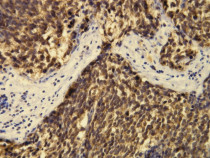ARG10846
anti-CD57 antibody [E20-I]
anti-CD57 antibody [E20-I] for IHC-Formalin-fixed paraffin-embedded sections and Human,Mouse,Rat
Overview
| Product Description | Rabbit Monoclonal antibody [E20-I] recognizes CD57 |
|---|---|
| Tested Reactivity | Hu, Ms, Rat |
| Tested Application | IHC-P |
| Host | Rabbit |
| Clonality | Monoclonal |
| Clone | E20-I |
| Target Name | CD57 |
| Antigen Species | Human |
| Immunogen | Synthetic peptide around the C-terminus of Human CD57. |
| Conjugation | Un-conjugated |
| Alternate Names | Glucuronosyltransferase P; CD57; LEU7; GlcAT-P; GLCATP; HNK1; GlcUAT-P; NK1; Beta-1,3-glucuronyltransferase 1; EC 2.4.1.135; Galactosylgalactosylxylosylprotein 3-beta-glucuronosyltransferase 1; GLCUATP; UDP-GlcUA:glycoprotein beta-1,3-glucuronyltransferase; NK-1 |
Application Instructions
| Application Suggestion |
|
||||
|---|---|---|---|---|---|
| Application Note | IHC-P: Antigen Retrieval: Boil tissue section in Citrate buffer (pH 6.0) for 25-35 min followed by cooling at RT for 20 min. * The dilutions indicate recommended starting dilutions and the optimal dilutions or concentrations should be determined by the scientist. |
Properties
| Form | Liquid |
|---|---|
| Buffer | 20 mM Tris-HCl (pH 8.0), 0.05% Sodium azide and 20 mg/ml BSA. |
| Preservative | 0.05% Sodium azide |
| Stabilizer | 20 mg/ml BSA |
| Storage Instruction | For continuous use, store undiluted antibody at 2-8°C for up to a week. For long-term storage, aliquot and store at -20°C or below. Storage in frost free freezers is not recommended. Avoid repeated freeze/thaw cycles. Suggest spin the vial prior to opening. The antibody solution should be gently mixed before use. |
| Note | For laboratory research only, not for drug, diagnostic or other use. |
Bioinformation
| Database Links |
Swiss-port # O35789 Rat Galactosylgalactosylxylosylprotein 3-beta-glucuronosyltransferase 1 Swiss-port # Q9P2W7 Human Galactosylgalactosylxylosylprotein 3-beta-glucuronosyltransferase 1 |
|---|---|
| Gene Symbol | B3GAT1 |
| Gene Full Name | beta-1,3-glucuronyltransferase 1 |
| Background | The protein encoded by this gene is a member of the glucuronyltransferase gene family. These enzymes exhibit strict acceptor specificity, recognizing nonreducing terminal sugars and their anomeric linkages. This gene product functions as the key enzyme in a glucuronyl transfer reaction during the biosynthesis of the carbohydrate epitope HNK-1 (human natural killer-1, also known as CD57 and LEU7). Alternate transcriptional splice variants have been characterized. [provided by RefSeq, Jul 2008] |
| Function | Involved in the biosynthesis of L2/HNK-1 carbohydrate epitope on glycoproteins. Can also play a role in glycosaminoglycan biosynthesis. Substrates include asialo-orosomucoid (ASOR), asialo-fetuin, and asialo-neural cell adhesion molecule. Requires sphingomyelin for activity: stearoyl-sphingomyelin was the most effective, followed by palmitoyl-sphingomyelin and lignoceroyl-sphingomyelin. Activity was demonstrated only for sphingomyelin with a saturated fatty acid and not for that with an unsaturated fatty acid, regardless of the length of the acyl group (By similarity). [UniProt] |
| Calculated MW | 38 kDa |
| PTM | The soluble form derives from the membrane form by proteolytic processing. [UniProt] |
Images (1) Click the Picture to Zoom In






